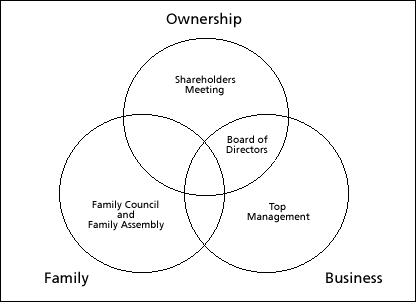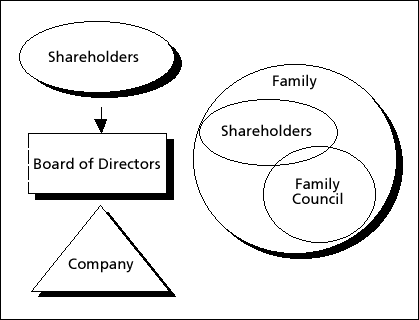Originally published in Harvard Business School: Working Knowledge (Sept 4, 2001)
The topic of governance is hot. Shareholders, managers, and business advisors are demanding improved governance of (typically public) companies by strengthening their boards of directors and developing more responsive shareholder relations.
But what happens when your board of directors is also your family?
The governance of a family business is more complicated than for non-family owned companies because of the central role of the family that owns and typically leads the business. In a family business, the business, the family, and the ownership group all need governance.
In family businesses (companies whose ownership is controlled by a single family) and other kinds of family enterprises including family foundations and family investment funds, the lack of effective governance is a major cause of organizational problems. In my two decades of working with family enterprises of all kinds, it has been clear that every business able to improve governance reaped lasting benefits.
If you are in a family enterprise, you need to learn the basics of governance and apply the best practices that exist in family business governance. But even non-family business leaders can benefit from considering how the problems of a family enterprise and non-family business are often the same. Personalities, passions, and power, after all, are at the heart of any enterprise.
In this article, I will describe effective overall governance of a family enterprise. In the following two articles in this series I will go into more detail explaining governance of the family business and governance of the business family—the family that owns the enterprise.
Effective Governance Means …
Let’s start by defining our topic. For any organization, be it a business, a family, a family foundation, or a Boy Scout troop, effective governance:
- Generates a sense of direction, values to live by or work by, and well-understood and accepted policies that tell organization members how they should behave or what they should do in certain circumstances. Examples of policies are hiring policies, promotion policies, debt policies, even fire emergency policies.
- Brings the right people together at the right time to discuss the right (important) things.
No organization is effective for long without doing these things. You should measure the effectiveness of your governance system by these outcomes, not by the boards and councils you can put in place. Effective governance can be done in an informal, casual manner. Or it might require formal structures (e.g. boards, councils) and processes (e.g. agendas, voting). The particular kinds of structures in your governance system can vary as long as your organization is producing the two outcomes described above.
If your organization is doing the above two activities in an informal, casual way, don’t change. But if your organization does not have these outcomes—a clear sense of direction, clear values, well-understood, sensible policies, does not assemble the right people in a timely way to discuss and decide the big issues facing your organization—then your governance system is flawed, should be improved, and probably needs to be made more formal. Given how difficult it is for most people to confront especially sensitive issues and to plan ahead, some degree of formality often helps people focus on their issues, work toward their goals, and resolve their differences. What is clear in my work with family enterprises is that a few well-composed and well-managed governance structures greatly help your chances of being effectively governed.
The world of family enterprise generates a mixture of business, family and ownership concerns that can make these systems emotionally charged environments for planning and problem solving. In these systems individuals must manage issues within and across three overlapping groups: the family, the business, and the ownership group (see Figure 1). The overlap among the three groups often leads to differing points of view among individuals depending on their location in the three circles. For example, family shareholders not employed in the business often have different views about the proper level of dividends than do their relative owners who work in the business. Both viewpoints are typically legitimate and must be reconciled in a respectful way to set direction for the enterprise and preserve harmony in the family. To effectively manage business, family and ownership concerns requires communication and decision making within and across the family, the business, and the ownership groups.
The overlap among the three groups often leads to differing points of view among individuals depending on their location in the three circles. For example, family shareholders not employed in the business often have different views about the proper level of dividends than do their relative owners who work in the business. Both viewpoints are typically legitimate and must be reconciled in a respectful way to set direction for the enterprise and preserve harmony in the family. To effectively manage business, family and ownership concerns requires communication and decision making within and across the family, the business, and the ownership groups.

Figure 1: The “3-circle” model of family business
Without belaboring an oft-made point about family business, reconciling these diverse concerns can be terribly difficult. Too often, family firms employ dysfunctional and short-sighted approaches to handle tensions, such as:
- Exclusion and secrecy—keeping some family members or shareholders out of conversations and keeping too many secrets from employees, owners or family members.
- Divide and conquer—relying on the support of some allies and excluding others from information and decision-making.
- Bribery—hiring relatives who do not deserve jobs, paying relatives more than they deserve, distributing more funds from the company than is responsible for the sake of preserving family harmony or maintaining certain individuals’ power.
These methods of addressing business-family-ownership tensions can provide some short-term relief but rarely resolve issues and predictably intensify them. Effective governance does not eliminate tensions in family enterprise systems. But it can reduce tensions and improve the effectiveness and harmony of these systems by clarifying family-business-ownership needs and managing the conversations needed to agree on goals, values, and policies.
“IF YOU ARE IN A FAMILY ENTERPRISE, YOU NEED TO LEARN THE BASICS OF GOVERNANCE AND APPLY THE BEST PRACTICES THAT EXIST IN FAMILY BUSINESS GOVERNANCE.”
— JOHN DAVIS
Size Doesn’t Matter
The absence of effective governance is by no means confined to smaller companies. The board of a large, fourth-generation family company created painful family turmoil when it dismissed the family chairman. The dismissal seemed abrupt to the chairman and his family allies, and long overdue by others. The family had the wisdom to address the ensuing family conflict and expose the weaknesses of its existing governance system: the family council was not consulted about the board’s issues with the chairman and did not understand its role in working with the board on such issues; the board of directors was too dominated by the family which had kept it paralyzed and unable to give the chairman pointed, critical feedback. This family business had the right structures in place; they just weren’t working properly. By strengthening the board and family council, and using the board, council, and family assembly to confront real issues facing the family and business, the business and most of the family moved beyond the removal of the chairman. They were also able to begin addressing the exclusion and secrecy at the root of problems in their system. This family business sold two of its three companies; the family is making a real attempt to become more supportive and cooperative. The improved governance system was at the heart of both gains.
Good governance contributes three fundamental ingredients for family businesses to function well:
- Clarity on roles, rights, and responsibilities for all members of the three circles;
- Encouraging family members, business employees, and owners to act responsibly;
- Regulating appropriate family and owner inclusion in business discussions.
Governance System Structures
So far, we have established the philosophy underpinning family business governance. Now, let’s review the structures in a family business governance system. Effective governance requires forums for the examination of the complicated and often emotional family, business, and ownership issues that confront family firms. The structures I recommend for any family-business-ownership system will vary somewhat based on the size and diversity of the business organization, the size and diversity of the ownership group, and the size, generation, and diversity of the family. One type of governance structure does not fit all family enterprise systems. But most family enterprise systems can be governed by a few structures, shown in Figure 2:
- Top management group;
- Board of directors or board of advisors;
- Family assembly and/or family council, and;
- Shareholders meeting and/or shareholder council.

Figure 2: Basic governance structures of the family business system
The membership and functions of these governance structures need to evolve as the business, family, and ownership groups change over time. A first-generation family business may only require (or tolerate) a small, informal advisory board rather than a board of directors. A third-generation family may need a family assembly to bring together the twenty-two members of the family annually to learn about and discuss the family business, plus a family council to help set policy for the family. It is quite clear that as ownership of the family business becomes more divided over generations, board composition and the role of the family council need to change. My advice is to create your board, family council, or family assembly to meet your current needs and to periodically discuss how to update these structures to meet the needs of your changing system.
The relationships among the governance structures is depicted in Figure 3 below:

Figure 3: Relationships among governance structures
This diagram illustrates the principle of the separate functions of the family council and the board of directors, or “the separation of church and state.” The family council sets policy for the family and recommends policy that concerns the family to the board (e.g. policy about family employment in the business). The board of directors sets policy for the business and may also make recommendations to the family council in matters that concern the business. These board and family council will ideally coordinate their work (we will discuss how later) but they should not overstep into each other’s domains.
At this point, consider my description of effective governance and assess how well your family enterprise performs according to the standards I have proposed. Then ask if your family enterprise system might be helped by a formal structure or two.
